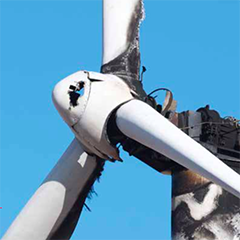Fire is the second leading cause of accidents in wind turbines after blade failure, with the damage caused going far beyond purely financial. Now, the launch of a new fire protection standard will protect the rapidly growing energy industry from financial, economic and reputational risks.
A new fire protection standard launched by DNV GL will ensure that the hazards presented by fire risk do not present an obstacle to further growth of the wind-generated power industry.
The global use of wind-generated power has increased significantly in recent years. According to the 2014 Joint Research Centre’s wind status report, global cumulative connected capacity soared to 370 GW in 2014, while the 52.8 GW installed capacity represented an annual record, delivering a 48 per cent increase compared to 2013. The same report confirmed that wind energy provided 8 per cent of Europe’s electricity in 2014, a figure that is expected to rise to 12 per cent by 2020.
Wind-generated power presents an obvious opportunity for governments looking to reduce energy emissions and safeguard long-term energy supply. So it is no surprise that global green energy investments increased by 17 per cent to $270 billion according to UNEP’s 9th Global Trends in Renewable Energy Investment 2015 report, with solar and wind energy representing the majority of the investment.
This growth, while extremely positive for the industry as a whole, does present some challenges for manufacturers. In particular, fire protection is becoming a major concern, as the risk of wind turbine fire presents a financial, economic and reputational threat to the industry. To ensure that wind energy reaches its potential as a mainstream energy source, it is vital that the industry takes measures to protect wind turbine investments from the risk of fire.
Onshore wind turbines typically cost around £2 million and generate an income that exceeds £500,000 per year. Clearly, any loss or downtime of these valuable assets makes the industry less viable and productive. However, fires create additional problems for the industry, not only affecting energy production and economic output, but also potentially emitting toxic fumes and damaging the industry’s green credentials, which in turn could affect future investment in wind turbines.



























